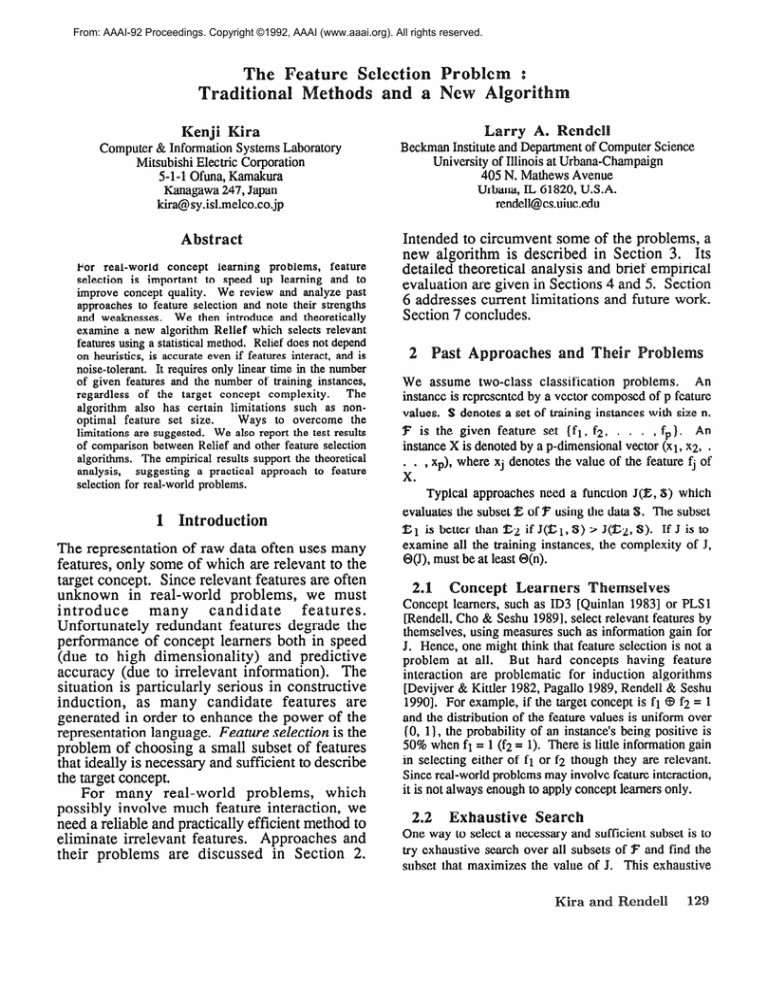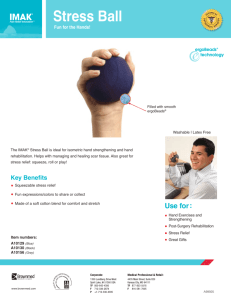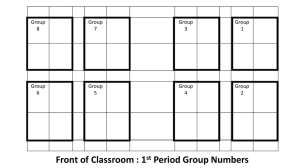
From: AAAI-92 Proceedings. Copyright ©1992, AAAI (www.aaai.org). All rights reserved.
Computer & In
Mitsubishi Electric Corporation
5-1-I Ofuna, Kamakura
Kanagawa 247, Japan
kira@sy.isl.melco.co.jp
For real-world concept learning problems, feature
selection is important to speed up learning and to
improve concept quality. We review and analyze past
approaches to feature selection and note their strengths
and weaknesses. We then introduce and theoretically
examine a new algorithm Relief which selects relevant
features using a statistical method. Relief does not depend
on heuristics, is accurate even if features interact, and is
noise-tolerant. It requires only linear time in the number
of given features and the number of training instances,
regardless of the target concept complexity.
The
algorithm also has certain limitations such as nonWays to overcome the
optimal feature set size.
limitations are suggested. We also report the test results
of comparison between Relief and other feature selection
algorithms. The empirical results support the theoretical
analysis,
suggesting a practical approach to feature
selection for real-world problems.
The representation of raw data often uses many
features, only some of which are relevant to the
target concept. Since relevant features are often
unknown
in real-world
problems,
we must
introduce
many
candidate
features.
Unfortunately
redundant features degrade the
performance of concept learners both in speed
(due to high dimensionality)
and predictive
accuracy (due to irrelevant information).
The
situation is particularly serious in constructive
induction,
as many candidate
features
are
generated in order to enhance the power of the
representation language. Feature selection is the
problem of choosing a small subset of features
that ideally is necessary and sufficient to describe
the target concept.
For many real-world
problems,
which
possibly involve much feature interaction, we
need a reliable and practically efficient method to
eliminate irrelevant features.
Approaches and
their problems
are discussed
in Section 2.
405 N. Mathews Avenue
IJrbana, IL 61820, U.S.A.
rendell@cs.uiuc.edu
Intended to circumvent some of the problems, a
new algorithm is described in Section 3. Its
detailed theoretical analysis and brief empirical
evaluation are given in Sections 4 and 5. Section
4 addresses current limitations and future work.
Section 7 concludes.
as
eir
s
We assume two-class classification problems.
An
instance is represented by a vector composed of p feature
values. S denotes a set of training instances with size n.
P is the given feature set ( fl , f2, . . . 9 fp }. An
instance X is denoted by a p-dimensional vector (xl, x2, .
9xp), where xj denotes the value of the feature fj of
x:
Typical approaches need a function J
evaluates the subset @ of P usi
@I is better than @2 if J(3E1)
examine all the training instance
O(J), must be at least O(n).
es
] or IxSl
[Rendell, Cho & Seshu 19891, select relevant features by
themselves, using measures such as information gain for
J. Hence, one might think that feature selection is not a
problem at all. But hard concepts having feature
interaction are problematic for induction algorithms
[Devijver & Kittler 1982, Pagallo 1989, Wendell $ Seshu
19901. For example, if the target concept is fl @ f2 = 1
and the distribution of the feature values is uniform over
{0, 1) , the probability of an instance’s being positive is
50% when fl = I (f2 = 1). There is little information gain
in selecting either of fl or f2 though they are relevant.
Since real-world problems may involve feature interaction,
it is not always enough to apply concept learners only.
xhaustive
Sear@
2.2
One way to select a necessary and sufficient subset is to
try exhaustive search over all subsets of F and find the
subset that maximizes the value of J. This exhaustive
search is optimal - it gives the smallest subset
maximizing J. But since the number of subsets of F is
2p, the complexity of the algorithm is O(2p).0(J). This
approach is appropriate only if p is small and J is
computalionally inexpensive.
Almuallim and Dietterich [ 1991J introduced FOCUS,
an exhaustive search algorithm Figure 11. They showed
that FOCUS can detect the necessary and sufficient
features in quasi-polynomial
time, provided (1) the
complexity of the target concept is limited and (2) there is
no noise. They defined the complexity for a concept c to
be the number of bits needed to encode c using their bitvector representation, and showed that FOCUS will
terminate in time O((2p)10g(s - p>,) where s is the
complexity of the target concept.
But the complexity can be as large as O(2p), for
example when all the features are relevant. Since the
complexity of the target concept is generally not known a
priori , we have to expect as much as 0(2Ppn) time for the
worst case when all the subsets of P are to be examined.
Moreover, with noisy data, FOCUS would select a larger
subset of F, since the optimal subset would not give clear
class separation.
FoCUS(S, F)
For i = 0, 1, 2, .*a
ForallEEPofsizei
If there exist no two instances in S that agree on
all features in @ but do not agree on the class
then return E and exit
Figure 1 FOCUS
2.3
Heuristic
definition of the feature selection problem, “select the best
d features from F, given an integer d 5 p” requires the size
d to be given explicitly and differs from ours in the sense.
This is problematic in real-world domains, because the
appropriate size of the target feature subset is generally
unknown. The value d may be decided by computational
feasibility, but then the selected d features may result in
poor concept description even if the number of relevant
features exceeds d only by 1.
Figure 2 shows Sequential Forward Selection (SFS)
and Sequential Backward Selection (SBS) algorithms.
These algorithms use a strong heuristic, “the best feature
to add (remove) in every stage of the loop is the feature to
be selected (discarded).” These algorithm are much more
efficient.
SFS’s complexity is O( &)-O(J).
SBS’s
complexity is @($0(J).
But the heuristic also causes a problem. These
algorithms perform poorly with feature interaction.
Interacting features (e.g. in protein folding, parity (Section
5)) may not maximize J individually, even though they
maximize it together.
2.4 Feature weight based approaches
Research in AI tends not to view feature selection as a
distinct problem but rather handles it as an implicit part of
induction.
The following approaches handle feature
selection implicitly.
STAGGER [Schlimmer 1987, Schlimmer & Granger
19861 selects source features for constructing a new
feature, judging from the feature weights based on their
relevance to the concept. However, since the relevance is
determined one feature at a time, the method does not work
for domains where features interact with one another.
Search Algorithms
Devijver and Kittler [1982] review heuristic feature
selection methods for reducing the search space. Their
SFS(S, F)
Is=0
SW& 3’)
E=P
For i=ltod
For i = 1 to (p - d)
Find a feature fmax E F - E, where
J(1EU {fmax), S) =
fE
@=@u
umax)
Return $5
max
IF-E
Find a feature fmax E iE, where
J(@- (fmax), S) = max J(E - (f}, S)
J(2: u (f), 8)
fE E
@=IE:-
(a) SFS
(b) SBS
Figure 2 Heuristic Search Algorithms
130
Learning:
Inductive
(fmax)
Return E
Callan, Fawcett and Rissland [ 199 l] also introduce an
interesting feature weight update algorithm in their casebased system CABOT, which showed significant
improvement over pure case-based reasoning in the
OTHELLO domain. CABOT updates the weights by
asking the domain expert to identify the best case. This
dependency on the expert makes the system less
autonomous, which is problematic for feature selection.
3
eIief Algorithm
Relief is a feature weight based algorithm inspired by
instance-based learning [Aha, Kibler & Albert 199 1,
Callan, Fawcett dz Rissland 19911. Given training data S,
sample size m, and a threshold of relevancy 2, Relief
detects those features which are statistically relevant to the
target concept. z encodes a relevance threshold (0 I 2 I
1). We assume the scale of every feature is either nominal
(including boolean) or numerical (integer or real).
Differences of feature values between two instances X and
Y are defined by the following function diff.
When Xk and yk are nominal,
<if Xk and yk are the same>
cif xk and yk are different>
When Xk and yk are numerical,
diff(xk, Yk)=(Xk- yk)/nUk
where nUk iS a normalization unit to normalize
the values of diff into the interval [0, l]
Relief@, m, 7)
Separate S into S+ = {positive instances] and
S’= (negative instances)
w = (O,O, . . . * 0)
Fori= 1 tom
Pick at random an instance X E S
Pick at random one of the positive instances
closest to X, Z+ 628+
Pick at random one of the negative instances
closest to X, Z- E Sif (X is a positive instance)
then Near-hit = Z+; Near-miss = Z’
else
Near-hit = Z-; Near-miss = Z+
update-weight(W, X, Near-hit, Near-miss)
Relevance = .(l/m)W
For i = 1 to p
if (relevancei 1 t)
then
fi is a relevant feature
else
fi is an irrelevant feature
update-weight(W, X, Near-hit, Near-miss)
Fori= 1 top
Wi = Wi - diff(xi, near-hiti)2 + diff(xi, near-missi)2
Figure 3 Relief Algorithm
Relief (Figure 3) picks a sample composed of m triplets of
an instance X, its Near-hit instance1 and Nearinstance. Relief uses the p-dimensional Euclid distance for
calls a
selecting Near-hit
and Near-miss.
routine to update the feature weight vecto
r every
weight
plet and to determine the average
elevanee
(of all the features to the target
concept). Finally, Relief selects those features whose
average weight (‘relevance level’) is above the given
threshold 2.
The following theoretical analysis shows that Relief
is different from other feature weight based algorithms in
that it can handle feature interaction, or that it is more
autonomous.
esretical
nalysis
Relief has two critical components: the averaged weight
elevance and the threshold 2.
ged vector of the value - (xi near-missj)2
for e h feature fi over m sample
(xitriplets. Each element of
levanee corresponding to a
feature shows how relevant the feature is to the target
concept. z is a relevance threshold for determining
whether the feature should be selected.
The complexity of Relief is O(pmn). Since m is an
arbitrarily chosen constant, the complexity is O(pn).
Thus the algorithm can select statistically relevant features
in linear time in the number of features and the number of
training instances.
Relief is valid only when (1) the relevance level is
huge for relevant features and small for irrelevant features,
and (2) 2 retains relevant features and discards irrelevant
features. We will show why (1) and (2) hold in the
following sections.
ellevance leve
Let A be a vector of random
ables (Si) such that
)2 + (xi - near-missj)2
date-weight
function
the value of 6; for each feature over m
Vance gives the averaged value of 6i for
accumulates
samples.
each feat
If fi is a relevant feature, xi and near-hiti
are
expected to be very close in the neighborhood of
contrast, the values of at least one of the relevant features
of X and Near -miss are expected to be different.
Therefore, near-hiti is expected to be close to xl more
often than near-misq to xi, and relevancei= E(6i) >>0.
1 We call an instance a near-hit of X if it belongs to the close
neighborhood of X and also to the same category as X. We
call an instance a near-miss when it belongs to the properly
close neighborhood of X but not to the same category as X.
Mira
and Rendell
131
If instead fi is an irrelevant feature, the values of
random variables xi, near-hit1 and near-miss1 do not
depend on one another. Therefore, (xi - near-hiti) and
(Xi - near-missi) are independent. Since near-hiti and
near-missi are expected to obey the same distribution,2
E((xi - near-hiti)2) = E((xI - near-missi)2)
E(6i) = - E((xI - near-hiti)2)
+ E((xi - near-missi)2) = 0
relevance; = E(Si) = 0
Therefore, statistically, the relevance level of a
relevant feature is expected to be larger than zero and that
of an irrelevant one is expected to be zero (or negative)2.
4.2
Threshold z
Figure 3 shows that those features whose relevance levels
are greater than or equal to 2 are selected and the rest are
discarded. Hence the problem to pick a proper value of 2.
Relief can be considered to statistically estimate the
relevance level 6; for each feature fi, using interval
estimation. First we assume all the features are irrelevant
(E(&) = 0). z gives the acceptance and critical regions of
the hypothesis.
acceptance-region = { eil I&-E(&)l<~)
= ( 4; I I ei I5 Z }
critical-region = ( & I I & - E(6i) I > z )
= { 5; I I ci I > 2 )
If the relevance level of a feature is in the acceptance
region of the hypothesis, it is considered to be irrelevant.
If the relevance level of a feature is in the critical region of
the hypothesis, it is considered to be relevant.
One way to determine z is to use Cebysev’s
inequality,
P(I p - E(p) I I ha(p)) > 1 - l/h2
for any distribution of p
where a(p) is the standard deviation of p and h > 0.
Since xi, near-hiti, and near-missi are normalized, -1
5 6i I 1. Since fi is assumed to be irrelevant, E(6i) = 0
and therefore O(6i) I 1. Since the relevance level
relevancei is the average of 6i over m sample instances,
E(relevancei) = 0 and o(relevancei) = o&)/G
5 l/G.
Therefore,
P(I relevance; I 5 hfi)
2 P(I relevance; I 5 ho(relevance;)) > 1 - l/h2
According to the inequality, if we want the probability of
a Type I error (rejecting the hypothesis when it is true) to
2Strictly speaking, the distributions differ slightly. Since
Relief does not allow X to be identical with Near-hit, some of
their irrelevant feature values are expected to be different. On
the other hand, since X and Near-miss are not identical (if
there is no noise), all of their irrelevant feature values can be
the same at the same time. This asymmetry tends to make
E(Si) negative for irrelevant features.
132
Learning:
Inductive
be less than a, l/h2 I a is sufficient. Therefore h = 1 /
d--a is good enough. It follows that z = h&=I/lrotm
is good enough to make the probability of a Type I error
to be less than a.
Note that Cebysev’s inequality does not assume any
specific distribution of 6i. h can usually be much smaller
than 1 / 6
Also, O(6i) can be much smaller than 1
(e.g. for the discrete distribution of (0 : l/2, 1 : l/2), d =
0.707. For the continuous uniform distribution over [0,
11, CT=0.0666). Since we only want z = ha, z can be
much smaller than I / 6.
While the above formula determines z by a (the value
to decide how strict we want to be) and m (the sample
size), experiments show that the relevance levels display
clear contrast between relevant and irrelevant features [Kira
& Rendell’92J. z can also be determined by inspection.
5 Empirical Evaluation
In section 2, we discussed three types of past approaches.
One is concept learners alone, another is exhaustive
search, the third is heuristic search. In this section, we
compare Relief with these approaches. ID3 represents
concept-learner-alone approach and also heuristic search a kind of sequential forward search [Devijver $ Kittler
19821, since it incrementally selects the best feature with
the most information gain while building a decision tree.
Exhaustive search is represented by FOCUS [Almuallim
& Dietterich 19911.
Figure 4 shows the results of comparing (1) ID3
alone, (2) FOCUS + ID3, and (3) Relief (m = 40,~ = 0.1)
+ ID3 in terms of predictive accuracy and learning time in
a parity domain. The target concept is fI @ f2 = 1. The
horizontal axis shows the size of the given feature set P in
which only two are relevant features. The results are the
averages of 10 runs.
The predictive accuracy of ID3 alone was inferior to
both FOCUS + ID3 and Relief + ID3. This shows the
importance of feature selection algorithms. With noisefree data, both FOCUS -o-ID3 and Relief + ID3 learned the
correct concept. FOCUS + ID3 is more effective than
Relief + ID3, because FOCUS can select the two relevant
features more quickly than Relief. With noisy data,
however, the predictive accuracy of ID3 with Relief is
higher than with FOCUS. In fact, Relief + ID3 typically
learns the correct concept. The learning time of FOCUS
+ ID3 increases exponentially as the size of P increases,
while that of Relief + ID3 increases only linearly. Thus
Relief is a useful algorithm even when feature interaction
is prevalent and the data is noisy. These results show that
Relief is significantly faster than exhaustive search and
more accurate than heuristic search.
z
-100
2
ID3
G
5 ‘O”
90
E
iti 80
u
4
70
60
5
#
Features
(a) Tests with noise-free data
FOCUS + ID3
.?? -- 1 Theoretical
Upperbound
5
10
#
15
Features
(b) Tests with noisy data (10% feature noise)
Figure 4 Test Results in Parity Domain
Relief requires retention of data in incremental uses.
However it can be easily modified for incremental update
of relevance levels. Relief does not help with redundant
features. If most of the given features are relevant to the
concept, it would select most of them even though only a
fraction are necessary for concept description.
Relief is applicable
only to the two-class
classification problem. However the algorithm can easily
be extended for solving multiple-class classification
problems by considering them as a set of two-class
classification problems. Relief can also be extended for
solving continuous value prediction problems.
Insufficient training instances fools Relief. Sparse
distribution of training instances increases the probability
of picking instances in different peaks or disjuncts
[Rendell & Seshu 19901 as Near-hit (Figure 3). It is
crucial for Relief to pick real near-hit instances. One way
is to give enough near-hit instances for all instances.
Another is to apply feature construction [Matheus &
Rendell 1989, Rendell & Seshu 1990, Yang, Blix &
Rendell 19911. By generating good new features, the
number of peaks of the target concept
Accordingly the same training instances
enough near-hit instances to detect relevance
features to the concept. These limitations
research directions.
is reduced.
may provide
of those new
also suggest
Relief is a simple algorithm which relies entirely on a
statistical method. The algorithm employs few heuristics,
and is less often fooled. It is efficient - its computational
complexity is polynomial (O(pn)). Relief is also noisetolerant and is unaffected by feature interaction. This is
especially important for hard real-world domains such as
protein folding.
Though our approach is suboptimal in the sense that
the subset acquired is not always the smallest, this
limitation may not be critical for two reasons. One is that
the smallest set can be achieved by subsequent exhaustive
search over the subsets of all the features selected by
Relief. The other mitigating factor is that the concept
learners such as ID3 [Quinlan I9831 and PLSI mendell,
Cho & Seshu 19891 themselves can select necessary
Kira and Rendell
133
features to describe the target concept if the given features
are all relevant.
More experiments and thorough theoretical analysis
are warranted. The experiments should include combining
our algorithm and various kinds of concept learners such
as similarity-based learners, and connectionist learners.
Relief can also be applied to IBL to learn relative weights
of features and integrated with constructive induction.
Acknowledgements
The authors thank David Aha for discussion on IBL
algorithms and Bruce Porter for discussion on feature
importance. Thanks also to the members of the Inductive
Learning Group at UIUC for comments and suggestions.
eferences
[Aha 19891 Aha, D. W. Incremental Instance-Based
Learning of Independent
and Graded Concept
Descriptions, Proceedings of the Sixth International
Workshop on Machine Learning.
[Aha 19911 Aha, D. W. Incremental Constructive
Induction: An Instance-Based Approach, Proceedings of
the Eighth International Workshop on Machine
Learning.
[Aha, Kibler & Albert 19911 Aha, D. W., Kibler, D. &
Albert, M. K. Instance-Based Learning Algorithms.
Machine Learning, 6,37-66.
[Aha & McNulty 19891 Aha, D. W. & McNulty, D. M.
Learning Relative Attribute Weights for Instance-Based
Concept Descriptions, Proceedings of the Eleventh
Annual Conference of the Cognitive Science Society.
[Almuallim & Dietterich 19911 Almuallim, H. &
Dietterich, T. G., Learning With Many Irrelevant
Proceedings
of the Ninth National
Features,
Conference on Artificial Intelligence, 199 1,547-552.
[Bareiss 19891 Bareiss, R., Exemplar-Based Knowledge
Acquisition : A Unified Approach to Concept
Representation,
Classification,
and Learning,
Academic Press.
[Breiman et al. 19841 Breiman, L., Friedman, J. H.,
Olshen, R. A. & Stone, C. J., Classification and
Regression Trees, Wadsworth, 1984.
[Callan, Fawcett & Rissland 19911 Callan, J. P.,
Fawcett, T. E. & Rissland, E. L., CABOT : An
Adaptive Approach to Case-Based Search, Proceedings
of the Twelfth International Joint Conference on
Artificial Intelligence, 199 1,803-808.
[Devijver & Kittler 19821 Devijver, P. A. & Kittler, J.,
Pattern Recognition : A Statistical Approach, Prentice
Hall.
[Kira & Rendell 19921 Kira, K. & Rendell, L. A., A
Practical Approach to Feature Selection, Machine
134
Learning:
Inductive
Learning : Proceedings of the Ninth International
Conference @IL92), 1992.
[Matheus & Rendell 19891 Matheus, C. & Rendell, L. A.
Constructive Induction on Decision Trees. Proceedings
of the Eleventh International Joint Conference on
Artificial Intelligence, 1989,645650.
pagallo 19891 Pagallo, G., Learning DNF by Decision
Trees, Proceedings of the Eleventh International Joint
Conference on Artificial Intelligence, 1989,639-644.
[Porter, Bareiss & Holte 19901 Porter, B. W., Bareiss, R.
& Holte, R. C. Concept Learning and Heuristic
Classification in Weak-Theory Domains, Artificial
Intelligence, 45229-263.
[Quinlan 19831 Quinlan, J. R. Learning Efficient
Classification Procedures and Their Application to
Chess End Games. Machine Learning : An Artificial
Intelligence Approach, 1983,463-482.
[Rendell, Cho & Seshu 19891 Rendell, L. A., Cho, H.
H. & Seshu, R. Improving the Design of SimilarityBased Rule-Learning Systems. International Journal of
Expert Systems, 2,97-133.
[Rendell & Seshu 19901 Rendell, L. A. & Seshu, R.
Learning Hard Concepts through Constructive
Induction: Framework and Rationale. Computational
Intelligence, Nov., 1990.
[Schlimmer 19871 Schlimmer, J. C., Learning and
Representation Change, Proceedings of the Fifth
National Conference on Artificial Intelligence.
[Schlimmer & Granger 19861 Schlimmer, J. C. &
Granger, R. H. Jr., Incremental Learning from Noisy
Data, Machine Learning 1,317-354.
[Yang, Blix & Rendell 19911 Yang, D-S., Blix, G. &
Rendell, L. A.
The Replication
Problem: A
Constructive Induction Approach, Proceedings of
European Working Session on Learning, march, 1991.








